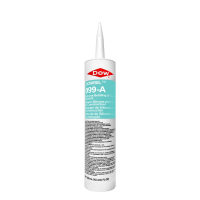Use the following steps to apply Dow 999A RTV silicone sealant for building and glazing:
Step 1: Preparation
The bonding surfaces on both new and existing work must be sound, dry, and free of all foreign matter and contaminants including grease, oil, dust, water, soap residue, frost, surface dirt, previously applied sealants, glazing compounds and protective coatings. Dow 999-A Silicone Building and Glazing RTV Silicone Sealant will adhere to cured silicone sealant when using a prep solvent wipe to remove any existing dirt.
Wipe down all surface areas using a clean, oil-free rag that is saturated with solvent such as xylol, toluol or methyl ethyl ketone. Due to the hazardous nature of these products, proceed with caution by always using protective gloves and a high quality breathing mask.Clean metal, glass and plastic surfaces by either mechanical or solvent procedures. Never clean surfaces with soap, detergent or any water-based cleaner. Wipe solvents on with a clean, oil and lint-free absorbent cloth. Remove the solvent before it begins to dry using a clean, dry cloth. Make sure that you don not saturate the surface with more solvent than is necessary. Also ensure that visibly clean surfaces are not left with a thin film of construction dust.
Step 2: Priming
When applying Dow 999-A Silicone Building and Glazing RTV Silicone Sealant to nonreflective glass surfaces, typically, priming is not required. Priming is usually needed when working with plastic and metal surfaces. If you are in doubt, test a sample area before you begin the applicatiion.
Step: 3 Masking
Areas adjacent to the joints need to be masked to ensure neat sealant lines. Do not allow masking tape to touch clean surfaces to which the silicone sealant will adhere. Tooling should be completed using one continuous stroke immediately after the sealant is applied and before the skin forms. As a rule of thumb, always remove the masking immediately following completed tooling and before a skin forms which is usually between 5 and10 minutes.
Step 4: Method of Application
Whew! You made it! It's time to apply!
Dow acetoxy sealants can be applied directly from the caulking cartridge with either an air-operated or a regular hand-operated cartridge gun. Be careful not to break the cartridge seal until you are ready to start. The clock starts ticking once the nozzle is clipped! Install backer rod material or joint filler, setting blocks, spacer shims and tapes as specified. Apply the sealant in a continuous operation using a steady, positive pressure adequate enough to effectively fill and seal the target joint.
Step 5: Tooling
Tooling is recommended and, if possible, should be completed in one continuous movement. Apply the sealant with light, but steady pressure to spread the material against the backup material used and the target joint surfaces. A tool with a concave profile is recommended to keep the sealant within the joint. When glazing, tool the sealant applied at the sill so that moisture and cleaning solutions will not collect. Be sure to fill the joint surface area within 10 minutes of application. Remove the masking tape before the surface skin begins to form. Once the surface skin begins to develop, it will be torn off when the tape is removed, leaving a rough surface. After applying the sealant and the skin has formed, be careful not to disturb the joint for at least 48 hours.
Step 6: Clean-Up
You are not quite done yet! Off the hammock!
Any excess sealant should be cleaned off your tools and all non-porous surfaces while it is in its uncured state by using a solvent, as mentioned, such as xylol, toluol or methylethyl ketone. Should the sealant accidentally make contact with the adjacent porous surfaces, the excess sealant should be allowed to progress through the initial cure. Afterwards, it should then be removed by abrasion or other mechanical means.
Step 7: Short-Term Storage
After use, simply remove the excess material from the tip. To reopen the cartridge, remove the cured plug from the opening.
LIMITATIONS
Dow Corning 999-A Silicone Building and Glazing RTV Silicone Sealant is not recommended for the following applications involving:
- Structural silicone glazing
- Joints where rough use or abrasion is apparent
- Prolonged water immersion
- Porous-type surfaces, such as masonry
- Building materials that might bleed oils, solvents, materials such as impregnated wood, oil-based caulks, green or partially vulcanized rubber gaskets or tapes
- Totally confined areas, because the sealant requires moisture for proper curing to take place
- Surfaces sensitive to corrosion by acetic acid vapors
- Surfaces that will be painted (reason: paint will not expand with the extensions of the sealant andcould very well crack and peel. (Be sure to complete all painting prior to using sealant.)
- Bonding to secondary seal of insulating glass units sealed with two-part silicone sealants
- Auto trim
- Appliance trim (i.e., adhesive trim)

